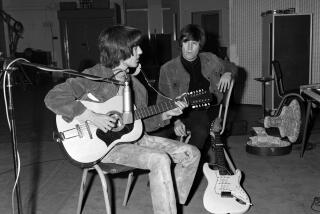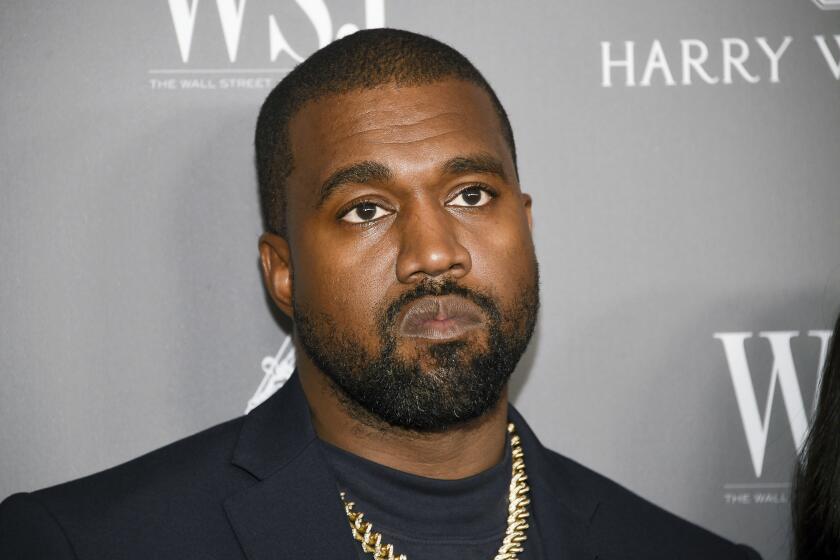Business Is Picking Up at Art Auctions
- Share via
NEW YORK — An auction of contemporary art here Wednesday night at Sotheby’s netted $17.6 million for 98 works, set nine world records and made millionaires of the sellers of two small paintings. It was the largest and most prestigious session of two sales this week at Christie’s and Sotheby’s where bidders paid a total of $33.2 million for works of mainly American contemporary art.
The Sotheby sale seemed to belie fears the art market would be seriously affected by October’s stock market crash. Sales totals made it the second most profitable of contemporary auctions, coming in just behind an $18.9- million Sotheby sale last May.
A packed house at Sotheby’s big ticket evening sale saw a 23-by-30-inch Willem de Kooning canvas, titled “Woman (Green),” go to an anonymous bidder for more than $2 million. The painting is a fairly minor example of a well-known genre of picture done by the Abstract Expressionist in the ‘50s. A Japanese private collector paid $1.2 million for an untitled 1948 Jackson Pollock, a drip painting about the same size. Million-dollar prices are still rare for works of contemporary art, especially for those once regarded as insignificant.
“It was a solid sale,” said Sotheby’s contemporary art expert Lucy Mitchell-Innes, “Sensible people were bidding wisely. If anything it was less hysterical (than previous sales).
“The contemporary market is dominated by American collectors. It is not as dependent on an international trade. I think the solidity of this sale is a statement about the art market in America. There is still plenty of money and energy out there,” she said.
Principal auctioneer John Marion, who conducts sales from a pulpit, said, “I found the bidding a little tense in the beginning but then people loosened up. There was an easy bidding pattern and lots of private collectors which I like to see.”
Small-fry dealers, journalists and curiosity-seekers were corraled in standing room at the peripheries during the brisk two-hour session. A glittering crowd of bidders crammed narrow rows of red folding chairs ogled by gimlet-eye Sotheby spotters watching for bids by waves of numbered paddles or secretly arranged winks, nods and ear-pulls.
In one vignette a man in his 20s insisted that he had stopped bidding on a work at $135,000 while the spotter had registered him as buying it at $155,000. After a few moments wrangling the handsome youth shrugged as if to say, “Well what’s another 20 grand?”
De Kooning works figured prominently among the top lots. Five bronze sculpture from the estate of art dealer Xavier Fourcade fetched a total of $2.5 million while a half-dozen paintings by Jean Dubuffet from the Hope and Abraham Melamed collection totted up $809,000.
Record prices for individual artists included Robert Rauschenberg’s 1959 “Backwash,” nearly doubling his previous auction record at $814,000. Morris Louis’ 1962 “Castor and Pollux” sold for $495,000 and a crystalline 1972 Photo-Realist “Bus Reflections” by Richard Estes knocked down at $484,000.
Other record setters included works by Malcolm Morley ($396,000), Joan Mitchell ($77,000), John Chamberlain ($39,000), Ellsworth Kelly ($352,000), Christo ($121,000) and Susan Rothenberg ($209,000).
Sotheby’s evening sale was broadly considered to be the most important of a brace of four contemporary sessions this week. It offered the largest number of quality works and predictably did better than a Tuesday evening event at Christie’s that brought $7.8 million for 64 lots, about one-quarter of which failed to sell.
Sotheby’s did much better, with only about 15% of its offerings receiving bids that did not meet their reserves (the lowest price the seller will accept.) Observers speculated about a curious pattern in the Sotheby’s sale. It was divided in almost equal thirds between some 30 works that went notably higher than their estimates and about 25 that failed to come up to their lowest estimate, causing about 15 to be “bought in” (not sell).
This roster included classics by California artists. Ed Ruscha’s 1963 “Smash” did not sell even though bidding equalled its low estimate of $150,000. Sam Francis’ 1953 abstraction “Blue” was bought in, even though bidding reached $750,000. Other works by these and other artists sold well fueling speculation that sellers had set unusually high reserves when the auctions were planned in the giddy ambiance prior to the Wall Street debacle. When these prices reached the newly cautious audience, even works of great quality met hard-headed rejection if considered too expensive.
Perhaps significantly, afternoon sessions of less expensive works sold better in some ways than big-ticket evening sales.
A Thursday morning session at Sotheby’s netted $5.7 million for some 200 words and was 86% sold. Another small Jackson Pollock topped the prices at $396,000.
Christie’s Wednesday afternoon sale was 93% sold, its 229 lots garnering around $2.1 million in a marathon sale running nearly four hours.
Top lots included works by Red Grooms ($60,500), Richard Estes ($52,800), Theodore Stamos ($49,500) and Andy Warhol ($46,000), whose better works consistently outstripped their estimates in all sales as did those of Alexander Calder.
Day sessions attract a homier crowd of dealers, entry-level collectors and sellers. One seller waited excitedly for a Warhol drawing that he had submitted to come to the block. Depicting a standing man, the drawing rocketed from its top estimate of $1,500 to sell for $5,500.
Beaming, the seller rose to leave.
“You got a good price,” commented a bystander.
“You bet I did,” retorted the delighted seller. “I found it in a trash can.”
More to Read
The biggest entertainment stories
Get our big stories about Hollywood, film, television, music, arts, culture and more right in your inbox as soon as they publish.
You may occasionally receive promotional content from the Los Angeles Times.










